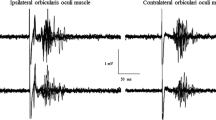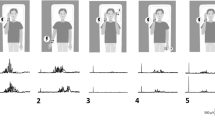Summary
Recovery curves of the R2 component of the blink reflex have been studied in 10 control subjects and 13 parkinsonian patients both after ipsilateral paired stimulation of the supraorbital nerve and after index finger stimulation. In control subjects, both types of conditioning induced a comparable marked inhibition lasting more than 600ms. In parkinsonian patients, inhibition was reduced after both conditionings. However, differences appeared in the magnitude of the changes: after paired stimulation, it was less significant (ANOVA and post-hoc Duncan's test: p=0.04) than after index finger stimulation (p=0.002). In that latter situation, the more marked reduction in inhibition is interpreted, in the light of current physiologic knowledge, by hypoactivity of the Nucleus Reticularis Giganto Cellularis (NRGC) which would make less efficient inhibitory interneurones in the trigemino-facial pathway. The results are thus compatible with the suggestion that NRGC is made indirectly less active in Parkinson's disease.
Similar content being viewed by others
References
Albin R, Young A, Penney J (1989) The functional anatomy of basal ganglia disorders. Trends Neurosci 1 12: 366–375
Anden N, Jukes M, Lundberg A, Vyklik L (1966) The effect of DOPA on the spinal cord. 1. Influence on transmission from primary afferents. Acta Physiol Scand 67: 373–386
Boulu P, Willer J, Cambier J (1981) Analyse électrophysiologique du réflexe de clignement chez l'homme: interaction des afférences sensitives segmentaires et intersegmentaires, des afférences auditives et visuelles. Rev Neurol (Paris) 137: 523–533
De Long M (1990) Primate models of movement disorders of basal ganglia origin. Trends Neurosci 13: 281–285
Delwaide PJ, Pepin JL, Maertens de Noordhout A (1991) Short-latency autogenic inhibition in patients with parkinsonian rigidity. Ann Neurol 30: 83–89
Delwaide PJ, Pepin JL, Maertens de Noordhout A (1993) The audiospinal reaction in parkinsonian patients reflects functional changes in reticular nuclei. Ann Neurol 33: 63–69
Delwaide PJ, Pepin JL, Maertens de Noordhout A (1996) From basal ganglia to motoneurons. Probable involvement of pathways relaying in the medulla. In: Battistin L, Scarlato G, Caraceni T, Ruggieri S (eds) Advances in neurology, vol 69. Lippincott-Raven, Philadelphia, pp 111–116
Dostrovsky J, Hu J, Sessle B, Sumino R (1982) Stimulation sites in periacqueductal gray, nucleus raphe magnus and adjacent regions effective in suppressing oral-facial reflexes. Brain Res 252: 287–297
Engberg I, Lundberg A, Ryall R (1968) Reticulospinal inhibition of transmission in reflex pathways. J Physiol 194: 201–223
Fanardjian VV, Kasabyan SA, Manvelyan LR (1983) Mechanism regulating the activity of facial nucleus motoneurones 2. Synaptic activation from the caudal trigeminal nucleus. Neuroscience 9: 823–835
Hoehn MN, Yahr MD (1967) Parkinsonism: onset, progression and mortality. Neurology 17: 427–442
Holstege H (1990) Neuronal organization on the blink reflex. In: Paxinos G (ed) The human nervous system. Academic Press, London, pp 287–296
Kimura J (1973) Disorder of interneurons in parkinsonism: the orbicularis oculi reflex to paired stimuli. Brain 96: 87–96
Kimura J (1983) Electrodiagnosis in diseases of nerve and muscle: principles and practice. FA Davis, Philadelphia, 672 p
Kimura J, Lyon LW (1972) Orbicularis oculi reflex in the Wallenberg syndrome: alteration of the late reflex by lesions of the spinal tract and nucleus of the trigeminal nerve. J Neurol Neurosurg Psychiatry 35: 228–233
Lee M, Marsden CD (1994) Movement disorders following lesions of the thalamus or subthalamic region. Mov Disord 9: 493–507
Lindquist C (1972) Facilitation and inhibition of facial reflexes in the cat induced by peripheral stimulation. Acta Physiol Scand 85: 126–135
Marsden CD, Obeso J (1994) The functions of the basal ganglia and the paradox of stereotaxic surgery in Parkinson's disease. Brain 117: 877–897
Martin G, Holstege G, Mehler W (1990) Reticular formation of the pons and medulla. In: Paxinos G (ed) The human nervous system. Academic Press, New York, pp 203–220
Meredith M, Wallace M, Stein B (1992) Visual, auditory and somatosensory convergence in output neurons of the cat superior colliculus: multisensory properties of the tectoreticulo-spinal projection. Exp Brain Res 88: 181–186
Nakashima K, Shimoyama R, Yokoyama Y, Iakahashi K (1993) Auditory effects on the electrically elicited blink reflex in patients with Parkinson's disease. Electroencephalogr Clin Neurophysiol 89: 108–112
Ongerboer De Visser B (1983) Comparative study of corneal and blink reflex latencies in patients with segmental or with central lesions. In: Desmedt JE (ed) Motor control mechanisms in health and disease. Raven Press, New York, pp 757–772
Ongeboer de Visser BW, Kuypers HGJM (1978) Late blink reflex changes in medullary lesions. Brain 101: 285–294
Penders C, Delwaide PJ (1973) Physiologic approach to the human blink reflex. In: Desmedt JE (ed) New developments in electromyography and clinical neurophysiology, 3. Karger, Basel, pp 649–657
Rossi A, Scarpini C (1992) Gating of trigemino-facial reflex from low-threshold trigeminal and extratrigeminal cutaneous fibres in humans. J Neurol Neurosurg Psychiatry 55: 774–780
Rushworth G (1972) Observation on blink reflexes. J Neurol Neurosurg Psychiatry 25: 93–108
Sessle B (1977) Modulation of alpha and gamma trigeminal motoneurons by various peripheral stimuli. Exp Neurol 54: 323–339
Takakusaki K, Kohyama J, Matsuyama K, Mori S (1993) Synaptic mechanisms acting on lumbar motoneurons during postural augmentation induced by serotonin injection in the rostral pontine reticular formation in decerebrate cats. Exp Brain Res 93: 471–482
Takakusaki K, Shimoda N, Matsuyama K, Mori S (1994) Discharge properties of medullary reticulospinal neurons during postural changes induced by intrapontine injections of carbachol, atropine and serotonin, and their functional linkages to hindlimb motoneurons in cats. Exp Brain Res 99: 361–374
Tamai Y, Munehisa I, Tsujimoto T (1986) Pathway of the blink refkex in the brainstem of the cat: interneurons between the trigeminal nuclei and the facial nucleus. Brain Res 380: 19–25
Valls-Sole J, Cammaroia A, Alvarez R, Hallett M (1994) Orbicularis oculi responses to stimulation of nerve afferents from upper and lower limbs in normal humans. Brain Res 650: 313–316
Webster D (1968) Clinical analysis of the disability in Parkinson's disease. Mod Treat 5: 257–282
Author information
Authors and Affiliations
Rights and permissions
About this article
Cite this article
Lozza, A., Pepin, J.L., Rapisarda, G. et al. Functional changes of brainstem reflexes in Parkinson's disease conditioning of the blink reflex R2 component by paired and index finger stimulation. J. Neural Transmission 104, 679–687 (1997). https://doi.org/10.1007/BF01291885
Received:
Accepted:
Issue Date:
DOI: https://doi.org/10.1007/BF01291885




